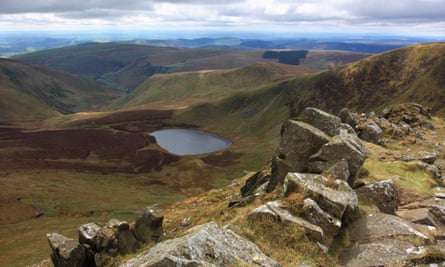Any summer’s day on top of Yr Wyddfa you may be forgiven for thinking all is well with Welsh tourism. People are queuing to touch the summit cairn, the cafe is rammed and the railway fully booked.
But the Welsh affairs committee at Westminster this week voiced serious concerns. It pointed out that in 2019, international visitors spent about £515m in Wales, less than 2% of the £28bn they spent in the UK overall. Closer scrutiny revealed other worrying signs: in 2022, there were almost 2.8bn day trips taken by British residents but only 6% happened in Wales, and on those visits people spent less than elsewhere in Britain.
For a country with so much spectacular mountain scenery and coastline, the committee report on Wales makes painful reading, especially since world tourism surveys regularly show that “natural beauty” is the key driver for visitors.
Rowland Rees-Evans, the chair of Mid-Wales Tourism, said: “You have to look at the infrastructure, it is lagging behind. And then there’s a lack of communication between the tourism industry, the various marketing bodies and government. If we could work together, the potential is massive.”
This view is echoed by others working in tourism. Richard Rees runs Celtic Deep, which takes visitors out to see marine wildlife around Pembrokeshire. He said: “There’s a lack of awareness of what amazing world-class wildlife experiences we have here: from puffin colonies on Skomer Island to sightings of tuna, whales, sharks and dolphins. There’s a huge market that is going untapped.”
So what are the tourists missing out on in Wales?

Scenic railways
Infrastructure is often cited as weak, but in fact Wales has several remarkable railways. Board the Cambrian line from Shrewsbury down to Aberystwyth and you pass through stunning mountain scenery and, in season, can spot ospreys nesting near Dyfi junction. The northern branch to Pwllheli then rattles past several remarkable coastal sights, including the Mawddach estuary and Harlech Castle. Further south, the Heart of Wales line, another underfunded and creaky public service, is also one of the world’s finest rail routes.
Suzy Davies, the chair of the Wales Tourism Alliance, said: “We have poor quality carriages and unreliable services. But the routes are magnificent.” These lines also connect to some of the world’s finest collection of heritage steam services: the Ffestiniog, Talyllyn and the Vale of Rheidol railways. Other lines are dotted all over, from the Brecon Mountain Railway in the south to the Welsh Highland up north.

The Coastal Path
Wales is one of only a handful of countries that can claim to have a fully operational footpath right around itself, and what a gem it is. Start with the 870-mile coastal route that takes in the glories of the Gower, Carmarthenshire and Pembrokeshire, but also the less well-known seascapes of Ceredigion and Gwynnedd. Follow that with the Offa’s Dyke path, 177 miles through border mountains, often next to, and even on, the underrated ancient monument itself. The word “dyke” barely does justice to a vast eighth-century infrastructure project, way beyond the capacity of any administration nowadays, it rises to eight-metre high earth rampart for some stretches across lonely and isolated mountains. Elsewhere there are too many blocked and unsigned paths, but the coastal route and Offa’s Dyke are triumphs.

Mountains
Yr Wyddfa takes the strain. Everyone climbs it. Meanwhile, a few miles away, other equally spectacular peaks can be peacefully unfrequented. Some are better known than others: Tryfan and Glyder Fach have great scrambles, further south there is Cnicht and Cadair Idris, the latter with wonderful views of the Irish Sea. These, however, are positively busy compared with the delights of Cadair Berwyn, Aran Fawddwy and Pumlumon Fawr, the highest mountain in mid-Wales and source of both the rivers Severn and Wye. Further east is Moel Famau, a hill topped by a tower. Down in Pembrokeshire, Foeldrygarn is home to an iron age hill fort and three bronze age cairns that were built when the hieroglyphic paint was still drying inside Tutankhamun’s tomb. Access is not always easy: some mountains do not have recognised summit paths, but the potential for hillwalkers is vast.

Slate
An industry that once dominated the landscape of north Wales lingers on as the ghost in the tourist machine. Old quarries are home to the fastest zip wires in the world and underground adventures like Go Below. The mines’ transport routes are now reborn as heritage railways. Real adventurers, however, treasure them as places to explore. You will need climbing skills and equipment to enjoy Eryri’s Dinorwic (this vast wonderland has access issues), but Llanfair near Harlech is more easily enjoyed. Slate was not the only mineral exploited, of course, and other mines that can be visited include coal and gold. At Parys, near Amlwch on Anglesey, is the wondrous orange moonscape of a former copper mine, once the largest in the world and mined since the bronze age.

Welsh language and culture
Once seen as the exclusive domain of fluent native speakers, there’s a recent shift towards inspiring interest and inclusivity (residential courses for beginners are available). Call it the Deadpool effect. In 2020, the Hollywood actors Ryan Reynolds and Rob McElhenney bought Wrexham AFC. Reynolds’s TV channel Maximum Effort then started hosting Welsh-language programmes for its US and Canadian audiences. “In a lighthearted and humble way, they’ve embraced the language,” said Davies, “It’s made a difference.” A new younger demographic are bringing a livelier and less judgmental approach as shown by the Welsh-language channel S4C’s Gogglebocs Cymru, which embraced all kinds of accents and levels of ability. That, and football of course, has brought American tourists to Wrexham, proving that anything is possible.
Stay connected with us on social media platform for instant update click here to join our Twitter, & Facebook
We are now on Telegram. Click here to join our channel (@TechiUpdate) and stay updated with the latest Technology headlines.
For all the latest Lifestyle News Click Here
